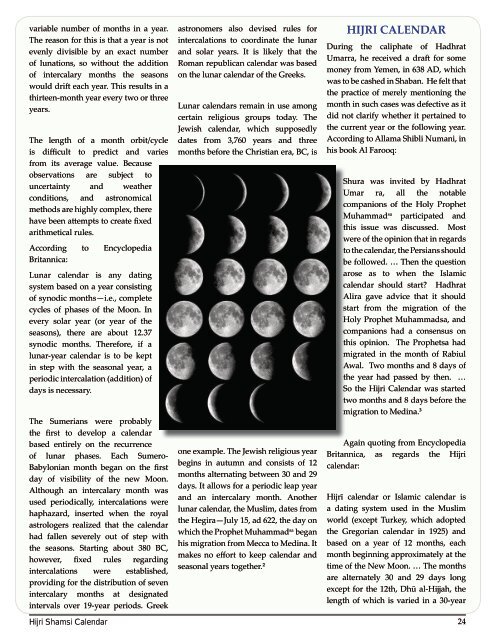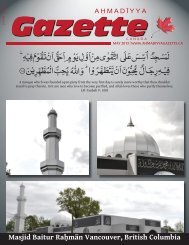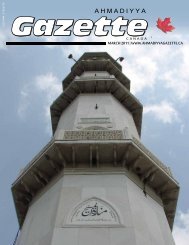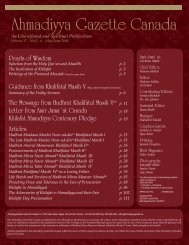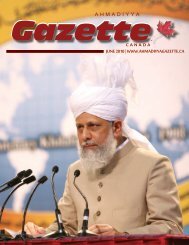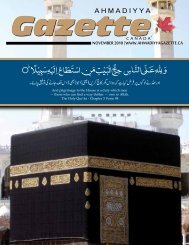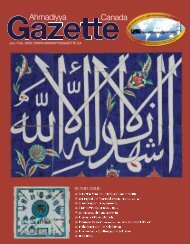Jan Feb 2010 - Ahmadiyya Gazette Canada
Jan Feb 2010 - Ahmadiyya Gazette Canada
Jan Feb 2010 - Ahmadiyya Gazette Canada
You also want an ePaper? Increase the reach of your titles
YUMPU automatically turns print PDFs into web optimized ePapers that Google loves.
variable number of months in a year.<br />
The reason for this is that a year is not<br />
evenly divisible by an exact number<br />
of lunations, so without the addition<br />
of intercalary months the seasons<br />
would drift each year. This results in a<br />
thirteen-month year every two or three<br />
years.<br />
The length of a month orbit/cycle<br />
is difficult to predict and varies<br />
from its average value. Because<br />
observations are subject to<br />
uncertainty and weather<br />
conditions, and astronomical<br />
methods are highly complex, there<br />
have been attempts to create fixed<br />
arithmetical rules.<br />
According to Encyclopedia<br />
Britannica:<br />
Lunar calendar is any dating<br />
system based on a year consisting<br />
of synodic months—i.e., complete<br />
cycles of phases of the Moon. In<br />
every solar year (or year of the<br />
seasons), there are about 12.37<br />
synodic months. Therefore, if a<br />
lunar-year calendar is to be kept<br />
in step with the seasonal year, a<br />
periodic intercalation (addition) of<br />
days is necessary.<br />
The Sumerians were probably<br />
the first to develop a calendar<br />
based entirely on the recurrence<br />
of lunar phases. Each Sumero-<br />
Babylonian month began on the first<br />
day of visibility of the new Moon.<br />
Although an intercalary month was<br />
used periodically, intercalations were<br />
haphazard, inserted when the royal<br />
astrologers realized that the calendar<br />
had fallen severely out of step with<br />
the seasons. Starting about 380 BC,<br />
however, fixed rules regarding<br />
intercalations were established,<br />
providing for the distribution of seven<br />
intercalary months at designated<br />
intervals over 19-year periods. Greek<br />
Hijri Shamsi Calendar<br />
astronomers also devised rules for<br />
intercalations to coordinate the lunar<br />
and solar years. It is likely that the<br />
Roman republican calendar was based<br />
on the lunar calendar of the Greeks.<br />
Lunar calendars remain in use among<br />
certain religious groups today. The<br />
Jewish calendar, which supposedly<br />
dates from 3,760 years and three<br />
months before the Christian era, BC, is<br />
one example. The Jewish religious year<br />
begins in autumn and consists of 12<br />
months alternating between 30 and 29<br />
days. It allows for a periodic leap year<br />
and an intercalary month. Another<br />
lunar calendar, the Muslim, dates from<br />
the Hegira—July 15, ad 622, the day on<br />
which the Prophet Muhammad sa began<br />
his migration from Mecca to Medina. It<br />
makes no effort to keep calendar and<br />
seasonal years together. 2<br />
HIJRI CALENDAR<br />
During the caliphate of Hadhrat<br />
Umarra, he received a draft for some<br />
money from Yemen, in 638 AD, which<br />
was to be cashed in Shaban. He felt that<br />
the practice of merely mentioning the<br />
month in such cases was defective as it<br />
did not clarify whether it pertained to<br />
the current year or the following year.<br />
According to Allama Shibli Numani, in<br />
his book Al Farooq:<br />
Shura was invited by Hadhrat<br />
Umar ra, all the notable<br />
companions of the Holy Prophet<br />
Muhammad sa participated and<br />
this issue was discussed. Most<br />
were of the opinion that in regards<br />
to the calendar, the Persians should<br />
be followed. … Then the question<br />
arose as to when the Islamic<br />
calendar should start? Hadhrat<br />
Alira gave advice that it should<br />
start from the migration of the<br />
Holy Prophet Muhammadsa, and<br />
companions had a consensus on<br />
this opinion. The Prophetsa had<br />
migrated in the month of Rabiul<br />
Awal. Two months and 8 days of<br />
the year had passed by then. …<br />
So the Hijri Calendar was started<br />
two months and 8 days before the<br />
migration to Medina. 3<br />
Again quoting from Encyclopedia<br />
Britannica, as regards the Hijri<br />
calendar:<br />
Hijrī calendar or Islamic calendar is<br />
a dating system used in the Muslim<br />
world (except Turkey, which adopted<br />
the Gregorian calendar in 1925) and<br />
based on a year of 12 months, each<br />
month beginning approximately at the<br />
time of the New Moon. … The months<br />
are alternately 30 and 29 days long<br />
except for the 12th, Dhū al-Hijjah, the<br />
length of which is varied in a 30-year<br />
24


